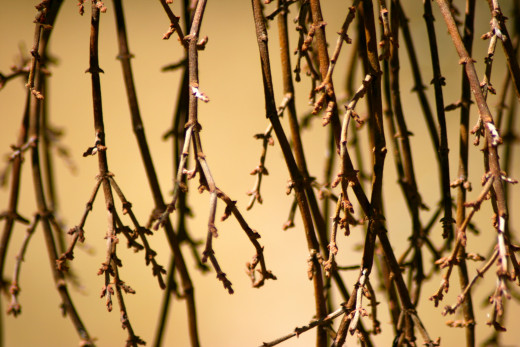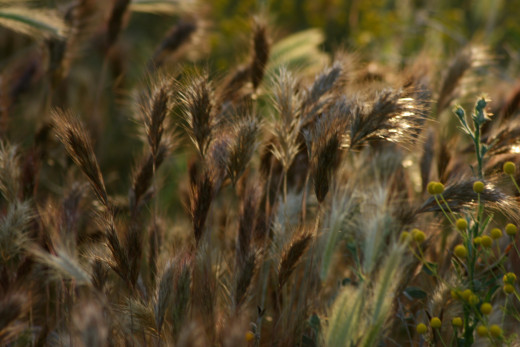Desert Textures: A Photographic Essay

I can't remember a time I didn't love the desert. I was born here, born loving it, born to appreciate the sensory delight that is the Sonoran. I revel in the scents and sights, the feel of the air, the patterns and textures. The textures: rough, sometimes hostile, a wonder of self-defense and survival (or not) against the hostile elements.

Everything here has a defense mechanism. Rattlesnakes have venom. Coral snakes have even more lethal venom. Bull snakes look a lot like rattlesnakes. King snakes look a lot like coral snakes. The cactus have spines, the ocotillo have thorns, and the creosote bush has a waxy foliage that tastes undesirable as well as protects it from the desiccating rays of the sun.
Yet rattlesnakes are ridiculously vulnerable when faced by a woman with a snake-pole. The cactus are easily dug out with a digging pole due to their shallow root system. Defense systems that worked for thousands of years against more natural forces are useless once humankind have invaded. We are the most invasive weed yet.

There is always death in the desert. Here, no tender woods embrace you as you fall. Lush vines don't crawl across your body; you don't nestle against mossy loam. It is the sun that consumes you, always the sun. Bones bleach, tree trunks lie exposed until termites and termite-hunting flickers drill into the wood, cactus skeletons stand upright as silent sentinels.
The desert reminds us: we are but temporary travelers.

Many years ago, a friend's dog happily romped back to her with a treasure in his mouth. It was large and oval -- the treasure, not the Doberman. My friend convinced him to drop the object, and quickly realized it was a human skull. The detectives, documenting the skull with photographs and measurements at the lab, were fortunate to find the brown recluse spider living inside the skull before anyone was bitten. A dog had loped around with the skull in its mouth; a woman had carried the skull back to her car; the detectives had transported it for forensic examination; all long before anyone noticed the brown recluse lurking within.
They're called recluses for a good reason.

And Coyote, the trickster, chose mortality, because if creatures didn't die, there'd be no more room for the newborn. Where the trees have fallen, other life is sustained. Turn over a slowly decomposing tree trunk and you must watch for scorpions. They lie in wait for the roaches and crickets that feed off the products of the rotting tree. Stand back and listen: there's a strange percussion. It's the flicker, often mis-called a woodpecker, drilling amazingly ovate holes into the wood, seeking termites.
Death makes room for life. It isn't always the life form we choose, but it is life.

Hosting a deafening droning of bees, the yellow puffs of mesquite flowers welcome the first hot days. Mesquite trees, much maligned by ranchers, are sometimes the only shade you'll find. Like just about everything else in the desert, they boast vicious thorns that make you ache when they've punctured you. Nothing bleeds quite like a mesquite wound, nor hurts quite the same way later.
Yet the bright yellow flower-puffs will soon create the seed-pods that dry and fall to the ground with an audible pop. Those dried pods fed the indigenous people: grind them with a mano and metate, and you'll have an aromatic flour. Leave them be, and everything from horses to domestic geese will snatch them up ravenously.

Everywhere is the orderly texture of the cactus. Artists know that perfect symmetry creates tension; Navajo rug-makers know that flaws let the evil spirits out. The saguaro knows that its semi-symmetrical rows of spines make for something more beautiful than perfect parallels.
During drought years, the growth portion of the saguaros draws inward. During drought-abundance cycles, the cactus develops lovely serpentine lines. During abundance, like us they grow too rotund, almost cartoonish.

At first blush, the prickly pear spines look to be laid out in a pattern. Upon closer inspection, they're just imperfect enough to be perfect. They appeal to the eye with a logical layout, but appeal to the heart with slightly undulating lines. The same lovely, languid, flowing waves repeat themselves in the stone walls of the canyon, the snake's trail across the sand, the silhouette of the mountain peaks against the next, nearer, layer of ridges.
Whoever designed the desert knew exactly what they were doing.


I like lichens. I'm not quite sure what to make of them, though -- I associate them with a damp place, not the desert. Yet here they are, living their simple existence against the volcanic rock. Lichens. Like me.

The downed branches and dead trees take on personalities and shapes. I can't bring myself to burn or bury the hundreds of gnarly dead trees on the ranch. They have that time-worn, weather-beaten texture -- evocative of many things. Some have hollows that look like a secret place to hide something special.
This one is the Murdered Woman. Every time I cross the path beside this downed branch, my mind first interprets the shape, the outline, as a murdered woman, fallen as she fought her attacker. Her legs are twisted in struggle and terror.
Perhaps I was in law enforcement for too long.


Green stick. That's what the Spanish name, palo verde, translates to in English -- the newer language of the desert. Before English, there was Spanish. Before Spanish, there was a variety of native tongues.
The palo verde hosts an abundance of phainopepla -- small black crested birds, like slender cardinals in shape, and phainopepla distribute mistletoe. The mistletoe is a parasite that lives upon the palo verde in great clumps, ultimately destroying the host tree. As the mistletoe itself dries, once detached from the tree, it turns a rich shade of rusty brown. It looks like so many fallen nails rusting on the ground.

The sun gives our life, and it takes away our life. In the desert, survivors must have a healthy respect for the sun. By mid-spring it has turned the annual weeds to brown or tan. What was once a meadow of green or yellow becomes a flaxen field. The hare barley, so tempting a carpet two weeks ago, becomes a hostile place: the awns become a nuisance to sock-wearing hikers, but can be a serious threat to the animal that inhales or ingests them.
Introduced from southern Europe, hare barley is often misidentified as foxtail. Here is a case of the hare being more dangerous than the fox: foxtails may frustrate, but the hare barley is harrowing.


What is it about dead cactus? Drive through Cave Creek, and you'll see rows of majestic saguaro skeletons for sale for hundreds of dollars and up. Live in the area and have tourists visit, and they'll almost invariably ask if they can take home a piece of that "beautiful wood" -- the cholla skeleton, with its distinctive patterns of oval holes in the rough woody branch.
There's no doubt, it's the texture. The unique, undeniable, rugged desert texture. Everything here bears its brand.

Coyote, when it is time for me to make more room for the new souls, let me lie upon the desert earth and let the sun bleach my bones. Perhaps I shall feed a few creatures, or provide a home for even more, before I am through. Eventually I will no longer be recognizable; and only then will I be completely one with the desert that I have always loved. My texture will be that of the gnarly trees and the sandy soil and the saguaro skeletons.
It will be just as it should be.
Enjoy More of My Desert
- Desert in Bloom
On a wet year, the desert unleashes an abundance of blooms from weeds and wildflowers. Flowers burst out in a profusion of color that many would never expect from a place misunderstood as barren.
- Cactus Flowers: The Lush Beauty of Spiny Plants
Those who think of the desert as a hostile place, forbidding and drab, have never taken time to appreciate the cactus blooms in springtime. Those spiny plants safeguard most exquisite blooms.
- Ten Things to Love About Cave Creek, Arizona
Welcome to quirky, iconoclastic, weird and wonderful Cave Creek, Arizona -- where cowboys, artists, bikers, and authors roam. Still a small town, Cave Creek has a big heart and a bigger attitude. Here is your virtual tour.
Enjoy a Western Novella, Set Against the Rugged Sonoran
Copyright (c) 2013 by MJ Miller
All rights reserved. No part of this article, in whole or in part, may be reproduced without the express permission of the author. Links, however, may be freely shared (and are appreciated!) If you are reading this anywhere but on Hubpages.com, you are reading stolen content.









